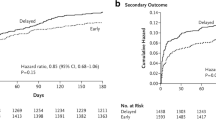Abstract
The optimal therapy for non-ST-segment-elevation acute coronary syndromes is the subject of considerable debate: is early catheterization and revascularization (early-invasive strategy) or continued medical therapy unless symptoms are refractory (early-conservative strategy) best? Although several clinical trials have sought to answer this question, the methodologies they employed have been widely criticized, and no consensus has been reached. The new antiplatelet therapies have proved beneficial for primary medical management and as adjuncts to percutaneous interventions. It is not yet clear, however, whether use of these therapies will preferentially benefit one of the treatment strategies.
Similar content being viewed by others
References
Kong DF, Califf RM, Miller DP, et al. Clinical outcomes of therapeutic agents that block the platelet glycoprotein IIb /IIIa integrin in ischemic heart disease.Circulation. 1998; 98: 2829–2835.
Vorchheimer DA, Badimon JJ, Fuster V. Platelet glycoprotein IIb/IIIa receptor antagonists in cardiovascular disease.JAMA. 1999; 281: 1407–1414.
Topol EJ. What role for catheter laboratories in unstable angina?Lancet. 1998; 352: 500–501.
Chen L, Chester MR, Redwood S, Huang J, Leatham E, Kaski JC. Angiographic stenosis progression and coronary events in patients with ‘stabilized’ unstable angina.Circulation. 1995; 91: 2319–2324.
Adgey AA, Mathew TP, Harbinson MT. Periprocedural creatine kinase-MB elevations: longterm impact and clinical implications.Clin Cardiol. 1999; 22: 257–265.
Narins CR, Miller DP, Califf RM, Topol EJ. The relationship between periprocedural myocardial infarction and subsequent target vessel revascularization following percutaneous coronary revascularization: insights from the EPIC trial.J Am Coll Cardiol. 1999; 33: 647–653.
Braunwald E, Mark DB, Jones RH, et al.Unstable Angina: Diagnosis and Management. Clinical Practice Guideline Number 10. Rockville, Md: US Dept of Health and Human Services, Agency for Health Care Policy and Research; 1994. AHCPR Publication No. 94-0602.
The TIMI IIIB Investigators. Effects of tissue plasminogen activator and a comparison of early invasive and conservative strategies in unstable angina and non-Q-wave myocardial infarction. Results of the TIMI IIIB Trial.Circulation. 1994; 89: 1545–1556.
Anderson HV, Cannon CP, Stone PH, et al. One-year results of the Thrombolysis In Myocardial Infarction (TIMI) IIIB clinical trial. A randomized comparison of tissue-type plasminogen activator versus placebo and early invasive versus early conservative strategies in unstable angina and non-Q wave myocardial infarction.J Am Coll Cardiol. 1995; 26: 1643–1650.
Boden WE, O’Rourke RA, Crawford MH, the Veterans Affairs Non-Q-Wave Infarction Strategies in Hospital (VANQWISH) Trial Investigators. Outcomes in patients with acute non-Q-wave myocardial infarction randomly assigned to an invasive as compared with a conservative management strategy.N Engl J Med. 1998; 338: 1785–1792.
Tu JV, Sykora K, Naylor CD. Steering Committee of the Cardiac Care Network of Ontario. Assessing the outcomes of coronary artery bypass graft surgery: how many risk factors are enough?J Am Coll Cardiol. 1997; 30: 1317–1323.
Madsen JK, Grande P, Saunamaki K, et al. Danish multicenter randomized study of invasive versus conservative treatment in patients with inducible ischemia after thrombolysis in acute myocardial infarction (DANAMI).Circulation. 1997; 96: 748–755.
Yusuf S, Flather M, Pogue J, the OASIS (Organisation to Assess Strategies for Ischaemic Syndromes) Registry Investigators. Variations between countries in invasive cardiac procedures and outcomes in patients with suspected unstable angina or myocardial infarction without initial ST elevation.Lancet. 1998; 352: 507–514.
The PURSUIT Trial Investigators. Inhibition of platelet glycoprotein IIb/IIIa with eptifibatide in patients with acute coronary syndromes.N Engl J Med. 1998; 339: 436–443.
Akkerhuis M, Boersma E, Harrington RA, Deckers JW, Califf RM, Simoons ML. Eptifibatide protects against adverse cardiac complications both before and during percutaneous intervention in patients with acute coronary syndromes without ST-elevation.J Am Coll Cardiol. 1999; 33(suppl A): 40A.
Topol EJ, Serruys PW. Frontiers in interventional cardiology.Circulation. 1998; 98: 1802–1820.
Topol EJ. Coronary-artery stents—gauging, gorging, and gouging.N Engl J Med. 1998; 339: 1702–1704.
The EPISTENT Investigators. Randomised placebo-controlled and balloon-angioplastycontrolled trial to assess safety of coronary stenting with use of platelet glycoprotein-IIb/ IIIa blockade.Lancet. 1998; 352: 87–92.
The OASIS Investigators. Comparison of the effects of two doses of recombinant hirudin compared with heparin in patients with acute myocardial ischemia without ST elevation: a pilot study.Circulation. 1997; 96: 769–777.
The OASIS-2 Investigators. Effects of recombinant hirudin (lepirudin) compared with heparin on death, myocardial infarction, refractory angina, and revascularisation procedures in patients with acute myocardial ischaemia without ST elevation: a randomised trial.Lancet. 1999; 353: 429–438.
The FRISC Study Group. Low-molecular-weight heparin during instability in coronary artery disease.Lancet. 1996; 347: 561–568.
Klein W, Buchwald A, Hillis SE, et al. Comparison of low-molecular-weight heparin with unfractionated heparin acutely and with placebo for 6 weeks in the management of unstable coronary artery disease: Fragmin in Unstable Coronary Artery Disease Study.Circulation. 1997; 96: 61–68.
Cohen M, Demers C, Gurfinkel EP, et al. A comparison of low-molecular-weight heparin with unfractionated heparin for unstable coronary artery disease.N Engl J Med. 1997; 337: 447–452.
Cairns JA, Gill J, Morton B, et al. Fish oils and low-molecular-weight heparin for the reduction of restenosis after percutaneous transluminal coronary angioplasty. The EMPAR Study.Circulation. 1996; 94: 1553–1560.
Karsch KR, Preisack MB, Baildon R, et al. Low molecular weight heparin (reviparin) in percutaneous transluminal coronary angioplasty: results of a randomized, double-blind, unfractionated heparin and placebo-controlled, multicenter trial (REDUCE Trial).J Am Coll Cardiol. 1996; 28: 1437–1443.
The FRISC II Investigators. Invasive compared with non-invasive treatment in unstable coronaryartery disease: FRISC II prospective randomised multicentre study.Lancet. 1999; 354: 708–715.
Cannon CP, Weintraub WS, Demopoulos LA, Robertson DH, Gormley GJ, Braunwald E. Invasive versus conservative strategies in unstable angina and non-Q-wave myocardial infarction following treatment with tirofiban: rationale and study design of the international TACTICS-TIMI 18 Trial.Am J Cardiol. 1998; 82: 731–736.
Author information
Authors and Affiliations
Rights and permissions
About this article
Cite this article
Goodman, D. Early-invasive or early-conservative management of patients with unstable angina or non-Q-wave myocardial infarction. Adv Therapy 17, 45–55 (2000). https://doi.org/10.1007/BF02868030
Issue Date:
DOI: https://doi.org/10.1007/BF02868030




